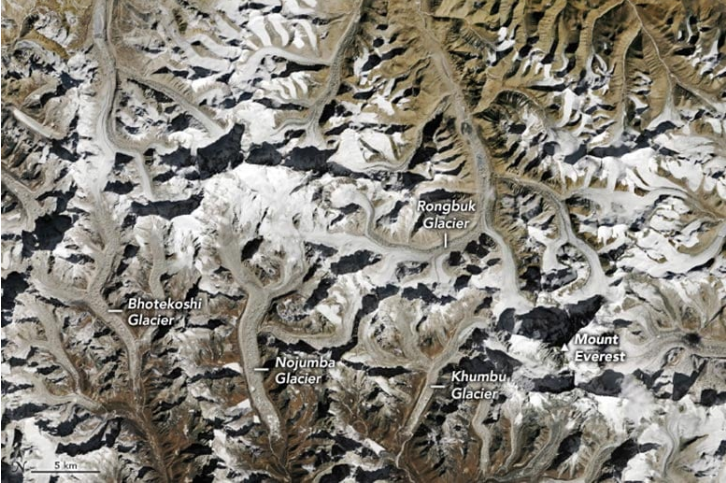


 2:3:27
2:3:27  2025-02-18
2025-02-18  1048
1048

More and more, mountain snow in the Mount Everest region is vanishing into thin air.
The snow line on Mount Everest’s glaciers is creeping higher, signaling a shift in the region’s winter conditions. Scientists point to warmer and drier weather, coupled with sublimation, as the culprits behind shrinking snow cover. This trend threatens water security for millions and could fuel more intense fire seasons in Nepal.
Snow Cover Shrinking in the Everest Region
Winters in the Himalayas, often called “the roof of the world,” are known for their extreme cold. Yet in recent years, snow cover around Mount Everest has been shrinking, with snow now mostly confined to higher elevations. Scientists studying the region’s snow and ice say that warmer and drier conditions are pushing the winter snow line higher — the altitude where seasonal snow remains on glacial ice. This shift could have serious consequences for water availability and wildfire activity in the region.
On January 20, 2025, satellite imagery from Landsat 9’s OLI-2 (Operational Land Imager-2) revealed an unusually high snow line (upper image above). By comparison, conditions were closer to normal on January 28, 2022, when the same sensor captured an earlier image (lower image above).
A New Normal for Winter Snow?
According to glaciologist Mauri Pelto of Nichols College, the lack of snow at lower elevations, as seen in January 2025, has become more common in recent winters. Pelto has studied Everest-region glaciers via satellite imagery and local weather station data. “The only year recently when January snow lines were near typical levels was 2022,” he said, adding that the high snow lines in January 2021, 2023, 2024, and 2025 might suggest a “new normal” for the area.
As opposed to North American and European glaciers that tend to accumulate mass through winter snowfall, the glaciers seen here are summer accumulation type glaciers. Approximately 75 percent of annual precipitation falls during the monsoon period of June through September, and these glaciers accumulate the most snow during this time. If the snow persists long enough, it can eventually transform into glacial ice.
Sublimation: A Hidden Force Behind Snow Loss
In the dry winter months in the Himalaya, glaciers typically have limited accumulation and an insignificant amount of melt. However, snow losses due to sublimation can be significant this time of year, Pelto and colleagues have found. Strong winds, low humidity, and unseasonably warm temperatures lead to snow evaporating straight into the atmosphere, causing the snow line’s elevation to rise.
Pelto calculated that the average snow line on Mount Everest region glaciers on January 28, 2025, was at approximately 6,100 meters (20,000 feet), having risen 150 meters (490 feet) since December 11, 2024. “This change was by sublimation, not melt,” he said. In those two months, Nepal experienced drier and warmer conditions than normal, officials from Nepal’s Department of Hydrology and Meteorology have reported. Compounding the issue, snow lines were already above average at the start of winter, Pelto said, after a dry start to 2024 and a warm, wet post-monsoon season.
The Broader Impact: Water and Fire Risks
Low seasonal snowpack and snow persistence affect downstream communities’ water security, reducing supplies for agriculture and other needs. A prolonged winter drought has also contributed to an early start to the 2025 fire season in parts of Nepal, according to news reports. Intense spring fires have followed exceptionally dry winters in Nepal in the past, for example in 2021.
Reality Of Islam |
|

Stanford, C

A new study

Researchers

A new chip-
 9:3:43
9:3:43
 2018-11-05
2018-11-05
10 benefits of Marriage in Islam
 7:5:22
7:5:22
 2019-04-08
2019-04-08
benefits of reciting surat yunus, hud &
 9:45:7
9:45:7
 2018-12-24
2018-12-24
advantages & disadvantages of divorce
 11:35:12
11:35:12
 2018-06-10
2018-06-10
 6:0:51
6:0:51
 2018-10-16
2018-10-16
 9:42:16
9:42:16
 2022-10-19
2022-10-19
 7:45:39
7:45:39
 2018-06-21
2018-06-21
 8:15:37
8:15:37
 2023-02-16
2023-02-16
 3:18:29
3:18:29
 2022-12-24
2022-12-24
a hero waters thirsty wild animals
 9:4:9
9:4:9
 2022-01-06
2022-01-06
 4:2:19
4:2:19
 2022-10-10
2022-10-10
 8:19:41
8:19:41
 2018-06-21
2018-06-21
 5:41:46
5:41:46
 2023-03-18
2023-03-18
| LATEST |